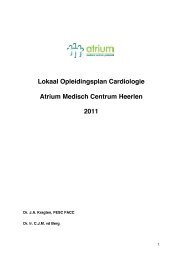Guidelines on the Management of Stable Angina Pectoris ... - Cardio
Guidelines on the Management of Stable Angina Pectoris ... - Cardio
Guidelines on the Management of Stable Angina Pectoris ... - Cardio
Create successful ePaper yourself
Turn your PDF publications into a flip-book with our unique Google optimized e-Paper software.
ESC <str<strong>on</strong>g>Guidelines</str<strong>on</strong>g> 15arteries by passing an ultrasound ca<strong>the</strong>ter into <strong>the</strong> cor<strong>on</strong>aryartery lumen. 244 Intravascular ultrasound allows for accuratemeasurement <strong>of</strong> cor<strong>on</strong>ary luminal diameter, assessment<strong>of</strong> eccentric lesi<strong>on</strong>s and Glagovian remodelling, and quantificati<strong>on</strong><strong>of</strong> a<strong>the</strong>roma and calcium depositi<strong>on</strong>. It also allowsfor detailed assessment <strong>of</strong> interventi<strong>on</strong>al target lesi<strong>on</strong>s,stent placement, appositi<strong>on</strong> and expansi<strong>on</strong>, and transplantvasculopathy. The technique has afforded advantages interms <strong>of</strong> our understanding <strong>of</strong> a<strong>the</strong>rosclerotic plaque depositi<strong>on</strong>and progressi<strong>on</strong>, <strong>of</strong>fering c<strong>on</strong>siderably improvedqualitative and quantitative assessment <strong>of</strong> cor<strong>on</strong>aryanatomy compared with c<strong>on</strong>trast arteriography and doubtless,has an important role in specialized clinical settings,particularly as an adjunct to cor<strong>on</strong>ary interventi<strong>on</strong>.However, it is more appropriately used in highly specificclinical settings and for research purposes than widespreadapplicati<strong>on</strong> as a first line investigati<strong>on</strong> for cor<strong>on</strong>arydisease. 245,246Invasive assessment <strong>of</strong> functi<strong>on</strong>al severity <strong>of</strong> cor<strong>on</strong>arylesi<strong>on</strong>sThe functi<strong>on</strong>al severity <strong>of</strong> cor<strong>on</strong>ary lesi<strong>on</strong>s visualized angiographicallymay be assessed invasively by means <strong>of</strong> measuringei<strong>the</strong>r <strong>the</strong> cor<strong>on</strong>ary flow velocity (cor<strong>on</strong>ary vasodilatoryreserve), or intracor<strong>on</strong>ary artery pressure fracti<strong>on</strong>al flowreserve (FFR). 7,247 Both techniques involve inducing hyperaemiathrough intracor<strong>on</strong>ary injecti<strong>on</strong> <strong>of</strong> vasodilatingagents. The cor<strong>on</strong>ary vasodilatory reserve (CVR) is <strong>the</strong>ratio <strong>of</strong> hyperaemic to basal flow velocity and reflects flowresistance through <strong>the</strong> epicardial artery and <strong>the</strong> corresp<strong>on</strong>dingmyocardial bed. It is dependent <strong>on</strong> microcirculati<strong>on</strong> aswell as severity <strong>of</strong> <strong>the</strong> lesi<strong>on</strong> in <strong>the</strong> epicardial vessel.FFR 248 is calculated as <strong>the</strong> ratio <strong>of</strong> distal cor<strong>on</strong>ary pressureto aortic pressure measured during maximal hyperaemia.A normal value for FFR is 1.0 regardless <strong>of</strong> <strong>the</strong> status <strong>of</strong><strong>the</strong> microcirculati<strong>on</strong>, and an FFR ,0.75 is deemedpathological.Physiological measurements as described may facilitatediagnosis in cases <strong>of</strong> intermediate angiographic stenoses,(visually estimated stenosis 30–70%). FFR measurement hasbeen shown to be useful in differentiating between patientswith favourable l<strong>on</strong>g-term outcome (i.e. patients withFFR .0.75) who do not need revascularizati<strong>on</strong>; and patientswho require revascularizati<strong>on</strong> (i.e. patients withFFR ,0.75) 249 but this investigati<strong>on</strong> is best reserved forspecific clinical circumstances or in deciding suitability forrevascularizati<strong>on</strong> ra<strong>the</strong>r than routine use.Recommendati<strong>on</strong>s for cor<strong>on</strong>ary arteriography for <strong>the</strong>purposes <strong>of</strong> establishing a diagnosis in stable anginaClass I(1) Severe stable angina (Class 3 or greater <strong>of</strong> Canadian<strong>Cardio</strong>vascular Society Classificati<strong>on</strong>), with a highpre-test probability <strong>of</strong> disease, particularly if <strong>the</strong> symptomsare inadequately resp<strong>on</strong>ding to medical treatment(level <strong>of</strong> evidence B)(2) Survivors <strong>of</strong> cardiac arrest (level <strong>of</strong> evidence B)(3) Patients with serious ventricular arrhythmias (level <strong>of</strong>evidence C)(4) Patients previously treated by myocardial revascularizati<strong>on</strong>(PCI, CABG) who develop early recurrence<strong>of</strong> moderate or severe angina pectoris (level <strong>of</strong>evidence C)Class IIa(1) Patients with an inc<strong>on</strong>clusive diagnosis <strong>on</strong> n<strong>on</strong>-invasivetesting, or c<strong>on</strong>flicting results from different n<strong>on</strong>invasivemodalities at intermediate to high risk <strong>of</strong>cor<strong>on</strong>ary disease (level <strong>of</strong> evidence C)(2) Patients with a high risk <strong>of</strong> restenosis after PCI if PCIhas been performed in a prognostically important site(level <strong>of</strong> evidence C)Risk stratificati<strong>on</strong>The l<strong>on</strong>g-term prognosis <strong>of</strong> stable angina is variable, and <strong>the</strong>range <strong>of</strong> treatment opti<strong>on</strong>s has expanded c<strong>on</strong>siderably fromsimple symptomatic c<strong>on</strong>trol to potent and <strong>of</strong>ten expensivestrategies to improve prognosis. When discussing risk stratificati<strong>on</strong>in stable angina, risk refers primarily to <strong>the</strong> risk <strong>of</strong>cardiovascular death, but <strong>the</strong> term is <strong>of</strong>ten more looselyapplied to incorporate cardiovascular death and MI, or insome cases even wider combinati<strong>on</strong>s <strong>of</strong> cardiovascular endpoints.The process <strong>of</strong> risk stratificati<strong>on</strong> serves a dualpurpose, to facilitate an informed resp<strong>on</strong>se to queriesregarding prognosis from patients <strong>the</strong>mselves, employers,insurers, n<strong>on</strong>-cardiology specialists c<strong>on</strong>sidering treatmentopti<strong>on</strong>s for comorbid c<strong>on</strong>diti<strong>on</strong>s and o<strong>the</strong>rs, and sec<strong>on</strong>dlyto assist in choosing appropriate treatment.For certain management opti<strong>on</strong>s, particularly revascularizati<strong>on</strong>and/or intensified pharmacological <strong>the</strong>rapy, prognosticbenefit is <strong>on</strong>ly apparent in high-risk subgroups, withlimited if any benefit in those whose prognosis is alreadygood. This mandates identificati<strong>on</strong> <strong>of</strong> those patients athighest risk, and <strong>the</strong>refore most likely to benefit frommore aggressive treatment, early in <strong>the</strong> assessment <strong>of</strong>stable angina.A 10-year cardiovascular mortality <strong>of</strong> .5% (.0.5% perannum) is determined to be high risk for <strong>the</strong> purpose <strong>of</strong>implementing primary preventi<strong>on</strong> guidelines. 250 However,absolute levels <strong>of</strong> what c<strong>on</strong>stitutes high-risk and low-riskare not clearly defined for those with establishedCVD. 68,251 This problem is linked to difficulties in comparingrisk predicti<strong>on</strong> systems across different populati<strong>on</strong>s, determiningaccuracy <strong>of</strong> individualized predicti<strong>on</strong>s <strong>of</strong> risk, andsyn<strong>the</strong>sis <strong>of</strong> multiple comp<strong>on</strong>ents <strong>of</strong> risk, <strong>of</strong>ten studied separately,into an estimate <strong>of</strong> risk for an individual. Added toc<strong>on</strong>tinuously evolving public and pr<strong>of</strong>essi<strong>on</strong>al percepti<strong>on</strong>s<strong>of</strong> what c<strong>on</strong>stitutes high- and low-risk over <strong>the</strong> past fourto five decades (since many <strong>of</strong> <strong>the</strong> initial risk predictorswere defined), <strong>the</strong> reas<strong>on</strong>s for this lack <strong>of</strong> definiti<strong>on</strong> arenot easily overcome.However, while awaiting development <strong>of</strong> a robust andportable risk predicti<strong>on</strong> model which incorporates all potentialaspects <strong>of</strong> risk stratificati<strong>on</strong>, <strong>the</strong>re is an alternativepragmatic approach, based <strong>on</strong> clinical trial data. Theinherent problems with bias when interpreting and generalizingclinical trial data must be recognized, but such data<strong>of</strong>fer an estimate <strong>of</strong> <strong>the</strong> levels <strong>of</strong> absolute risk achievablewith modern c<strong>on</strong>venti<strong>on</strong>al treatment even in patients withproven vascular disease. This in turn facilitates anestimati<strong>on</strong> <strong>of</strong> what may be accepted as c<strong>on</strong>stituting high,low, and intermediate risk in a c<strong>on</strong>temporary setting for<strong>the</strong> purposes <strong>of</strong> determining <strong>the</strong> threshold for invasiveinvestigati<strong>on</strong> or intensified pharmacological <strong>the</strong>rapy.The cardiovascular mortality and MI rate observed in <strong>the</strong>placebo arms <strong>of</strong> large trials <strong>of</strong> sec<strong>on</strong>dary preventi<strong>on</strong> or














